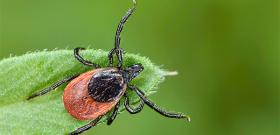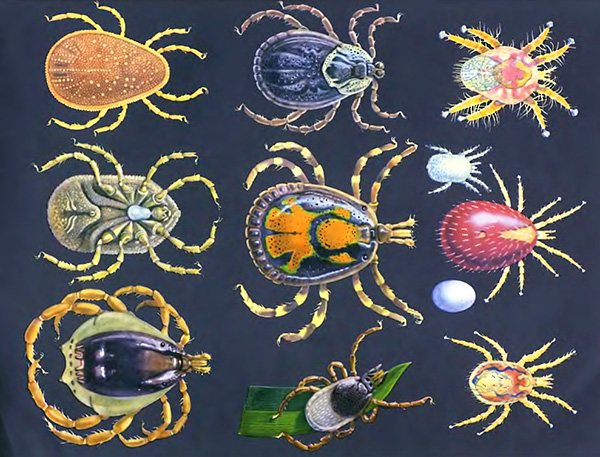
Ticks are an extensive subclass (Acari) of the phylum Arthropoda (Arthropoda). This is one of the oldest groups of arachnids, dating back to the early Devonian. It is characterized by a rich species composition and a significant heterogeneity of forms: at the moment it is known more than 50,000 types of ticks, however, many scientists believe that the fauna of Acari has been studied by only 20%.
Among the variety of mites, there are those that are dangerous to humans, as they can cause significant damage to our health. These include, among other things, representatives of the order Parasitiformes, otherwise - parasitiform mites.
Their bites can cause dermatoses, paralysis, anemia, and even death from the development of tick-borne infections. They are carriers of such dangerous diseases as tick-borne encephalitis, Lyme disease (borreliosis), tick-borne ehrlichiosis, spotted fever and many others.
General characteristics of parasitiform mites
The order of parasitiform mites comprises less than a third of all known mites. This is a less rich and diverse group, for example, compared to Acariform mites.
In total, the taxon Parasitiformes includes about 5,000 species and is divided into 3 superfamilies:
- Gamazoid mites;
- Uropods;
- Ixodides.

Hyalomma marginatum
Most of them are external hematophagous parasites, which have adapted to long-term bloodsucking and facultatively use the host as a habitat while feeding.Some switched to feeding on the juices of living plants (Uropodina). Saprophages are also rare (they feed on the decaying remains of animals and plants).
Parasitiform mites differ strikingly from acariform mites - both in terms of morphological structure and in terms of biology. The first and, perhaps, the most important difference is the division of the body into tagmas. Acariform mites have a segmented structure; metamerism is especially well traced on the abdomen. Related to this is the type of reproduction characteristic of this group - anamorphosis.
On a note
Anamorphosis is a type of reproduction in which the larva and adult differ in the number of segments that make up the body. Accordingly, in the process of ontogenesis, with each molt, the larva builds up (adds) segments, as if lengthening at the same time. This type of reproduction is typical for most centipedes, trilobites and acariform mites.
As for parasitiform mites, the evolution of this group proceeded by reducing the number of segments and their fusion, up to the complete disappearance of metamerism. In highly organized Parasitiformes, the body is completely devoid of traces of segmentation and has a bag-like appearance.

Development occurs with metamorphosis, in which there are 4 stages: egg, larva, nymph and adult.
Thus, parasitiform mites are characterized by the arachnoid type of tagmosis, with opposition between protosome and opisthosome. These departments are connected motionlessly, and in more highly organized forms they merge into a single whole, therefore Parasitiform mites are sometimes called arachnids (in the sense of similarity to spiders, and not from a systematic point of view).
Gamasid mites
Gamasid mites make up the majority of the order Parasitiform mites.This is the most numerous superfamily, including small ticks up to 3 mm in size, with a body covered with a large number of well-developed scutes. Gamazids are widespread everywhere, and live in the soil, in accumulations of organic remains, in burrows and nests of animals - both vertebrates and invertebrates.
The photo below shows a bee with a Varroa mite on its back:

As for life forms, predators and a variety of polyphages predominate in the group. There are facultative and obligate parasites (burrow, nest and pasture). Among them, there are also permanent cavity exoparasites that live in the respiratory system of birds and animals, as well as in the auditory canals of ruminants.
Some types of gamasid mites can attack a person and transmit to him pathogens of dangerous infectious diseases that they carry.
It is interesting
Parasitiform mites from the superfamily Gamazov are characterized by settlement at the expense of other animals - phoresia. This is very important for the inhabitants of random substrates, such as droppings and animal carcasses, where mites feed on insect eggs and larvae. The entire life cycle of the tick takes place in such a substrate, but females can migrate over considerable distances with insects that flock to a rotting substrate or droppings to disperse the species.
Another important feature in terms of survival and stability of the species of the Gamazov superfamily is their ability for parthenogenetic reproduction. The female just needs to get to a suitable substrate - and she can establish a new settlement there on her own.
Through nesting cohabitation and phoresia, some gamasid mites have moved to parasitism on small birds and mammals.So, for example, free-living predators can suck blood from the wounded part of the host. Species unable to pierce the integument can gnaw through the thin skin of newborn mammals and hatched birds.
This behavior is not full-fledged parasitism, however, as a factor in the transition to obligate bloodsucking, this type of additional feeding is of particular interest.
Next, consider the most typical representatives of gamasid mites.
The corpse mite (Poecilochirus necrophori) is a species that lives on corpses and feeds on decaying tissues and dead insects. Nymphs of the 2nd age are settled with the help of gravedigger beetles:
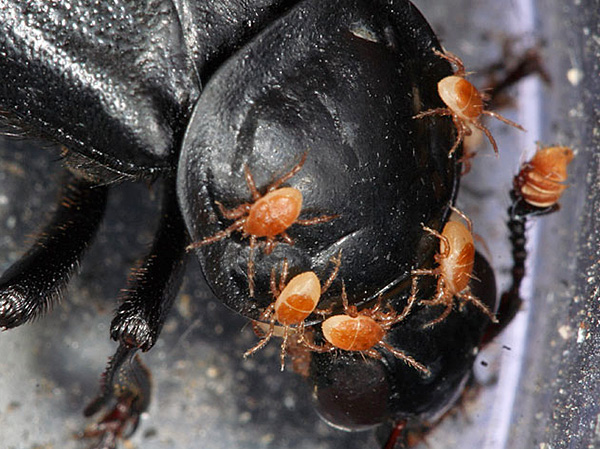
The chicken mite (Dermanyssus gallinae) is an example of a dangerous nest parasite. It lives in poultry houses, in the nests of wild birds, in cages with songbirds. It feeds on the blood of birds, mainly at night, and hides in shelters during the day:
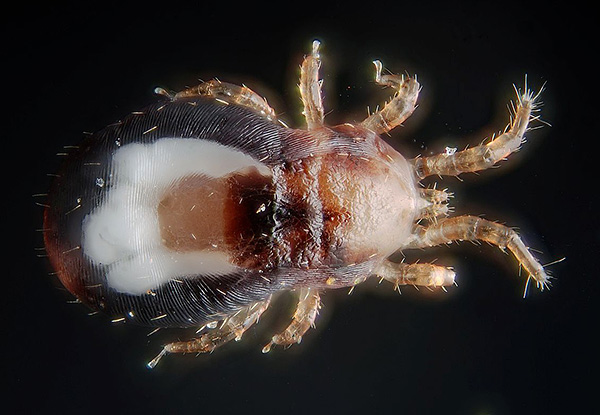
A hungry female chicken mite is approximately 0.7 mm long, yellow in color, and when fed, it increases significantly in size and turns red due to blood in the digestive system. In the process of digestion of blood, the body darkens.
Chicken mites can form foci of mass reproduction: in poultry houses with a strong infection under the sheathing there can be a continuous swarming mass of individuals of different ages and degrees of saturation. These parasitiform mites cause particular harm to poultry farming: birds do not grow well, do not rush, young animals often die. The chicken mite can also bite a person, causing severe dermatitis.
The bird mite (Dermanyssus hirundinis) lives in the nests of wild birds and can survive considerable periods of time without food.It hibernates in nests, and in the spring comes out of diapause after the arrival of new hosts.
Superfamily Ixodida (Ixodids)
Ixodids are the largest among Parasitiforms, they have a complex oral apparatus, aimed at cutting the integument of the victim and firmly fixing it in the skin of the host. This is a specialized group of obligate bloodsuckers, represented exclusively by parasitic forms.
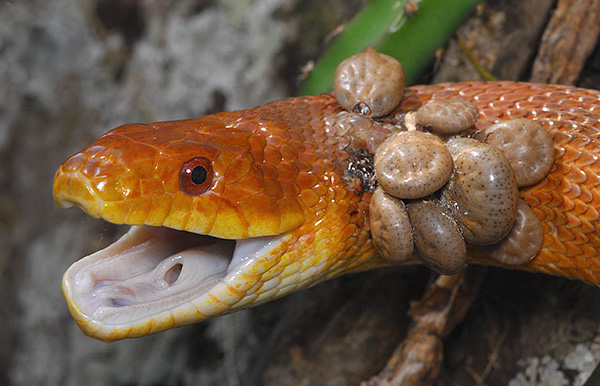
Hungry species of mites of the superfamily Ixodida reach 5 mm, and fed ones - up to 20 mm and even more. The group is represented by two families:
- Argas mites (Argasidae);
- ixodid ticks (Ixodidae).
They differ both in morphology and biology, and in the nature of distribution.
Argazids live in arid climates, down to deserts, and hunt at night. These are active predators capable of pursuing their prey over considerable distances.
Ixodids are confined to a more temperate and humid climate, where they inhabit forest belts, parks, and wet pastures. For them, the lurking type of hunting is more characteristic.
The photo below shows a typical representative of ixodid ticks - dog tick (Ixodes Ricinus), lying in wait for the owner in the grass:
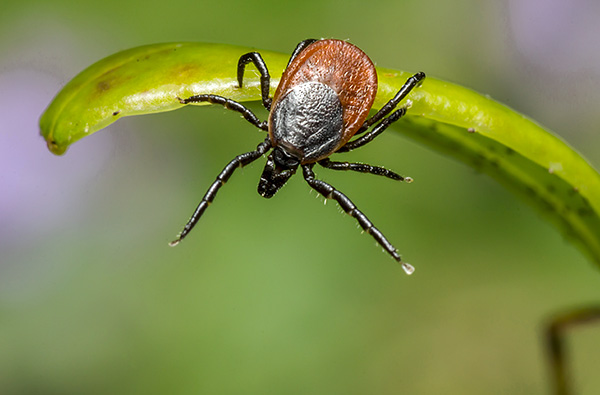
Argas and ixodid ticks are carriers of a number of dangerous diseases in humans and domestic animals.
Argas mites
Argas mites are easy to distinguish by their characteristic habit. The body is almost completely devoid of chitinous shields and is covered with a soft and elastic cuticular sac, which forms characteristic folds on the body. When feeding, when the parasite is sucked up by blood, the folds straighten out, and the volume of the body increases greatly.
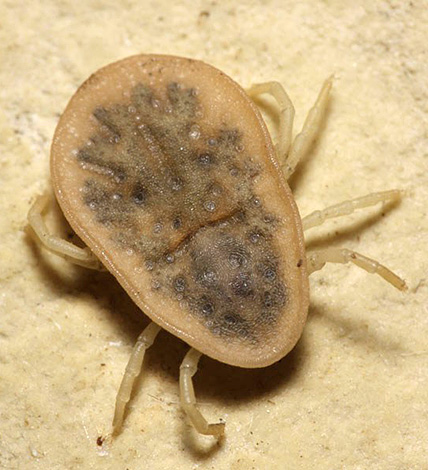
It is interesting
In the Middle Ages, argas ticks were collected in large quantities and placed at the bottom of special pits, where the criminal was lowered.In Central Asia, such pits were called bed pits. Such pits were not torture chambers - they were chambers specifically for killing, since the death of a person occurred quickly and painlessly due to the loss of blood sucked out by ticks.
Argasovs can be found in shaded areas: crevices of rocks, in burrows, grottoes. Often these parasitiform mites act as synanthropes, seeking shelter and food in human dwellings.
On a note
Some experts believe that the evolution of the Argasov family went in close conjunction with man and his dwelling, as the most favorable place for the life and full development of the parasite. In desert conditions, any cool place that is protected from direct sunlight and has a sufficient supply of moisture and food resources is ideal for maintaining the population of argasus mites at the proper level.
Argasids pose a great danger to humans, as they carry pathogens of a number of tick-borne relapsing fevers - severe, debilitating diseases common in hot countries. These are natural focal diseases. The natural reservoirs of typhoid pathogens are small rodents, insectivores (hedgehogs), jackals, foxes.
Ticks become infected in the process of bloodsucking, during feeding. Moreover, pathogens in the body of the carrier persist for a long time (often throughout the life of the parasite) and can be transmitted from the female to offspring through the egg membrane.
A person usually becomes infected through the bite of a tick, falling into its habitat, which coincides with the focus of typhus. The trace from the bite of an infected argas mite is specific: after a while, a red ring forms around the puncture site, then inflammation begins, a papule appears at the site of the bite, which persists for several weeks.
The main carrier of relapsing fever in Central Asia is the village tick (Ornithodoros papillipes).
Another widespread type of argas ticks is the Persian tick (Argas persicus) - a carrier of avian typhus:
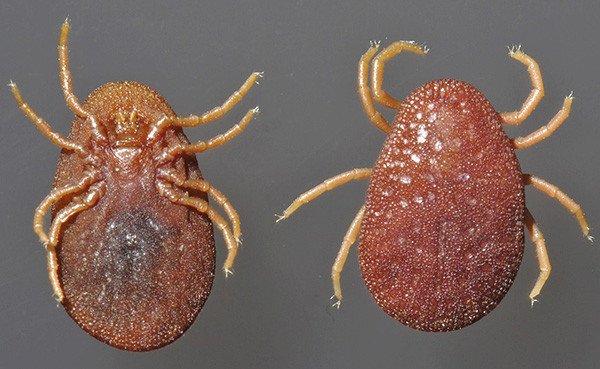
This parasite greatly harms the poultry industry in the eastern regions.
Ixodid ticks are highly specialized pasture blood-sucking parasites.
Ixodid ticks are distributed throughout the continents. and within most natural zones - from taiga to steppes and semi-deserts. These are highly specialized waiting pasture parasites that inhabit exclusively the subsistence habitats of their hosts.
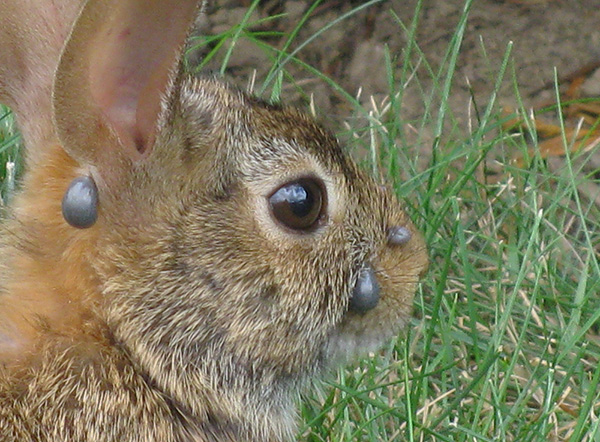
The rarity of encounters with hosts has greatly changed the life cycle and feeding patterns of these parasitiform mites. Ixodids use the host during feeding as a full-fledged substrate for life, therefore, in the process of evolution, they have developed a whole range of adaptations to long-term obligate exoparasitism.
Ixodidae are distinguished by the so-called harmony of digestion, molts and egg production, the number of which, by the way, can reach tens of thousands from one female. Such a high fecundity compensates for the mass death of ticks during host deficiency, despite their ability to starve for about two years.
Unlike argasids, ixodids show breeding seasonality, but just like argasid mites, they are distinguished by extensive polyphagy and regular changes of hosts depending on the situation. Mating usually takes place on the host.
Most ixodid develop on three hosts, but there are also two- and one-host species (see also the article Parasitic mites: interesting facts). With such an intensive change of hosts, ideal conditions are created for the transfer of pathogens of dangerous diseases, which is facilitated by the prolonged feeding of the parasite.
On a note
On the territory of Russia and the CIS there are more than 50 species of Ixodids. In the tundra, these parasitiform mites are practically absent, but they are widespread in taiga, northern, and mountain forests.
The most famous representative is taiga tick (Ixodes persulcatus) is a carrier of tick-borne encephalitis virus. The size of its hungry adults is 3-4 mm, and the fed ones increase in size by 5-7 times.
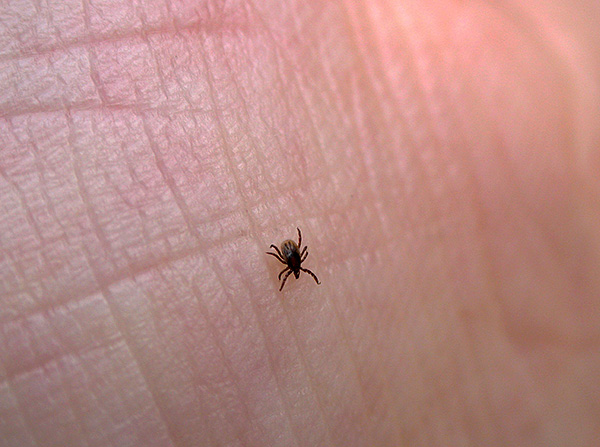

The dorsal shield is dark brown with a metallic sheen. In females, the shield covers 2/3 of the back; in males, the shield is complete, covering the entire dorsal part of the body of the arachnid.
Life cycle taiga tick passes through the three-host type. The larvae feed on small rodents, birds and reptiles. Nymphs choose a larger prey for themselves. Imago (adult individuals) mainly feed on large animals and humans.
hibernate taiga mites in the forest litter, among leaf litter. They are active in spring and autumn, when the humidity indicators are most favorable. The prey search mechanism is expectant; extremely rarely, the parasite can pursue the prey at a short distance. An attack on a person occurs from grassy vegetation and from low shrubs.
The dog tick (Ixodes ricinus) is very similar to the taiga tick, whose habitat is located somewhat to the south:
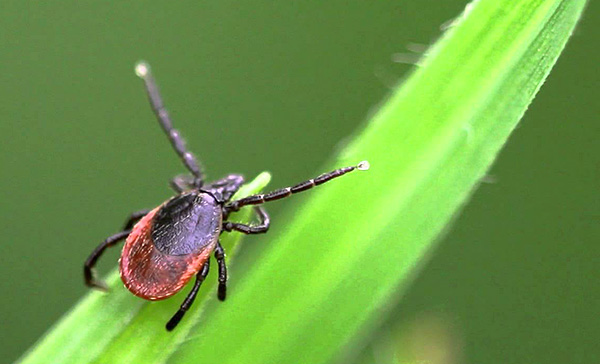
The species prefers broad-leaved and mixed forests, pastures.The life cycle is similar to that of the taiga, but the dog tick is more widespread and more common.
Ixodes ricinus can often be seen on domestic and farm animals. For humans, contact with the parasite poses a serious threat, as this tick carries many diseases, including Lyme disease and Western forms of tick-borne encephalitis.
Ticks as dangerous parasites of humans and domestic animals
The above description of typical representatives of the order of parasitiform mites does not reflect the entire diversity of the group, but is aimed only at a general acquaintance with it. As noted earlier, group polymorphism is enormous. Related to this is a wide range of practical issues related to parasitiform mites as carriers of dangerous diseases in humans and domestic animals.
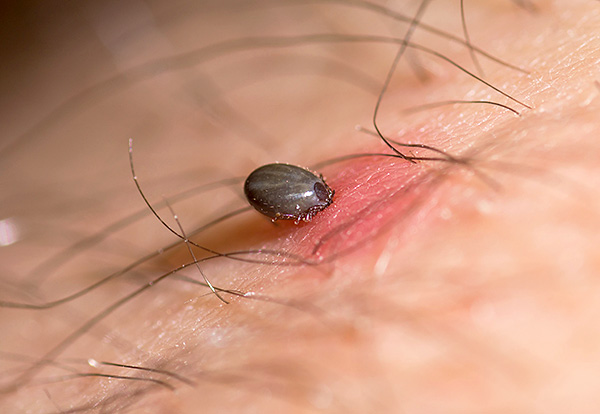
The following parasites are of particular medical and veterinary importance:
- The chicken mite is a parasite of poultry that causes significant harm to the poultry industry. It can also attack a person;
- Settlement tick - an inhabitant of arid zones, a carrier of relapsing fever;
- The taiga tick is the main carrier of spring tick-borne encephalitis;
- The dog tick is the most widespread and typical species of the superfamily, a carrier of pathogens of western forms of tick-borne encephalitis and Lyme disease.
An interesting video: can ticks bite into inanimate flesh?


